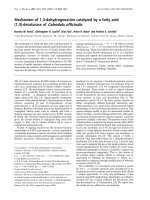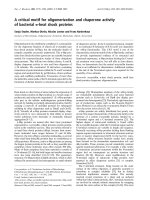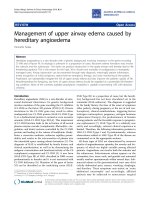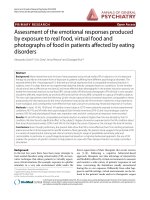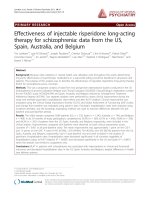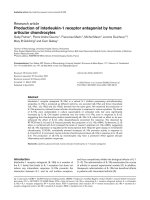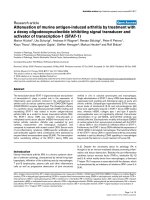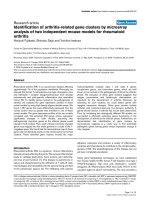Báo cáo y học: "Effectiveness of counseling for anxiety and depression in mothers of children ages 0-30 months by community workers in Karachi, Pakistan: a quasi experimental study" ppsx
Bạn đang xem bản rút gọn của tài liệu. Xem và tải ngay bản đầy đủ của tài liệu tại đây (700.77 KB, 9 trang )
Ali et al. BMC Psychiatry 2010, 10:57
/>Open Access
RESEARCH ARTICLE
© 2010 Ali et al; licensee BioMed Central Ltd. This is an Open Access article distributed under the terms of the Creative Commons Attri-
bution License ( which permits unrestricted use, distribution, and reproduction in any
medium, provided the original work is properly cited.
Research article
Effectiveness of counseling for anxiety and
depression in mothers of children ages 0-30
months by community workers in Karachi,
Pakistan: a quasi experimental study
Niloufer S Ali
1
, Badar S Ali
2
, Iqbal S Azam*
3
and Ali K Khuwaja
4
Abstract
Background: The prevalence of anxiety/depression is quite high during the perinatal period but unfortunately its
detection and treatment have been less than satisfactory. Moreover, many women are reluctant to take
pharmacotherapy for fear of excretion of drugs into their breast milk. This study assesses the effectiveness of
counseling from minimally trained community health workers in reducing anxiety/depression, the rate of recurrence
and the interval preceding recurrence in women during first two and a half years after childbirth.
Methods: In a quasi-experimental study, community women from two under-privileged communities were trained in
data gathering, teaching healthy child-rearing practices, basic counseling skills, and screening for anxiety/depression
by using an indigenously developed questionnaire, the Aga Khan University Anxiety and Depression Scale (AKUADS).
The diagnosis was further confirmed by a clinical psychologist using DSM IV criteria. After obtaining consent, 420
women were screened and 102 were identified as having anxiety/depression. Screening was carried out after 1, 2, 6, 12,
18, 24 and 30 months of a live birth. Only 62 out of 102 agreed to be counseled and received eight weekly sessions.
AKUADS was re-administered at 4 weeks and 8 weeks after the beginning of counseling; this was followed by the
clinical psychologist's interview for confirmation of response. After recovery, screening was continued every 3 months
for detection of recurrence throughout the study period. Out of the women who had declined counseling 12 agreed
to retake AKUADS after 4 and 8 weeks of diagnosis. Independent samples t-test, chi-square test, Repeated Measures
ANOVA and Kaplan Meier technique were used for the analysis.
Results: A significant decline in level of anxiety/depression was found in both the counseled and the non-counseled
groups at 4 and 8 weeks (p-value < 0.001) but the counseled group fared better than the non-counseled for recovery,
reduction in the rate of recurrence and increase in the duration before relapse.
Conclusions: As our results cannot be generalized; further studies need to be carried out, to assess the benefit of
incorporating minimal counseling skills in the training of community health workers.
Background
Globally the prevalence of mental health and psychoso-
cial problems is high during pregnancy and after birth. It
is reported that almost one in four women in developing
countries suffers from anxiety/depression around the
period of childbirth [1], which can lead to a chronic or
recurring depressive course throughout life [2]. A litera-
ture review of 143 research studies undertaken in 40
countries around the world reported that the prevalence
of postpartum depression (PPD) in Asian countries
ranged from 11% to 60.8% [3].
The mean overall prevalence of anxiety and depressive
disorders in the Pakistani population has been reported
to be 34% with higher rates in women than in men [4]. Ali
et al have reported a prevalence of 30% among women of
reproductive age group in a semi-urban community of
Karachi, Pakistan [5]. Studies done in urban tertiary care
* Correspondence:
3
Department of Community Health Sciences, Aga Khan University, Karachi,
Pakistan, Stadium Road, P. O. Box 3500, Karachi 74800, Pakistan
Full list of author information is available at the end of the article
Ali et al. BMC Psychiatry 2010, 10:57
/>Page 2 of 9
settings in Pakistan, have reported figures ranging from
24% - 42% [6,7]. Other community-based studies from
rural Pakistan have reported prevalence ranging from
28% - 36% in postpartum women [8,9]. A cohort study
from rural Pakistan has reported persistent postpartum
depression in 56% of those who developed PPD [10].
Depression after childbirth affects the health of the
mother as well as the health, growth and development of
the child [11]. Studies have revealed that perinatal
depression is associated with poor growth, high risk of
diarrhoea and reduced uptake of immunization [12,13].
Currently the detection and treatment of depression
after childbirth is less than satisfactory and many women
are reluctant to take pharmacotherapy for fear of excre-
tion of drugs into their breast milk [14]. Studies from high
income countries have reported that psychotherapeutic
approaches, such as cognitive behaviour therapy, inter-
personal therapy or problem solving therapy are effective
treatments for depression [15]. A few randomized trials
from low income and middle income countries have also
reported similar findings [16,17]. Substantial decrease in
depressive symptoms in women after miscarriage has
been reported after six sessions of interpersonal counsel-
ing [18]. A randomized controlled study conducted by
Rahman et al in a poor rural community in Pakistan has
shown that integration of cognitive behaviour therapy
(CBT) into routine work of community health workers
more than halved the rate of depression in prenatally
depressed women compared with those receiving routine
care only. In addition to symptomatic relief, the interven-
tion group had less disability, better overall social func-
tioning and the benefit persisted after one year [19]. Bhar
et al have reported that patients treated with either phar-
macotherapy or cognitive therapy showed similar results
[20].
No published findings to date suggest that antidepres-
sant medication reduces future risk of depressive epi-
sodes after discontinuation [21], whereas cognitive
therapy has been shown to provide protection against
relapse and possible recurrence [22]. Hollon et al have
reported higher percentages of relapses and recurrences
among patients who were on pharmacotherapy than on
cognitive therapy [23].
In a randomized controlled trial Ali et al. found signifi-
cant improvement in women of reproductive age who
were suffering from anxiety and depression after eight
weekly counseling sessions by minimally trained commu-
nity women [24]. Based on this experience, this study was
conducted to assess the benefits of counseling from mini-
mally trained community health workers working with
anxious and depressed women during the first two and a
half years after childbirth, and to assess the rate of recur-
rence and the interval preceding recurrence of anxiety/
depression after counseling.
Methods
Study design, site and duration
This is a quasi-experimental study from an action
research program to assess "The effect of postpartum
anxiety and depression on early childhood growth and
development," implemented in two semi-urban under-
privileged communities (Qayoomabad and Manzoor Col-
ony) of Karachi, a mega city of Pakistan from February
2004 to January 2007.
Study participants and sample
A total of 420 consenting women (155 from Manzoor
Colony and 265 from Qayoomabad) were enrolled after
live childbirths. Out of these, 102 women (34 from Man-
zoor Colony and 68 from Qayoomabad) developed anxi-
ety/depression during the study period. Detailed
information about the recruitment process is given else-
where [25].
Instruments used
a. Aga Khan University Anxiety and Depression Scale
(AKUADS)
This is a screening instrument for anxiety and depression
developed from symptoms of anxious and depressed
patients noted verbatim in the local lingua franca Urdu
and validated in the community keeping the psychiatrist's
interview as the gold standard [26,27]. It is a 25 item scale
(13 psychological and 12 somatic items) that covers most
of the clinical features considered characteristic of anxi-
ety and depressive disorders. Each item has four response
options (never, sometimes, often, always) scored from 0
to 3. At a cut-off score of 19 it has a sensitivity of 74%,
specificity of 81%, a positive predictive value of 63% and a
negative predictive value of 88% [27]. It has been used in
several studies in Pakistan due to its near 100% linguistic
validity [5,24-29]. As AKUADS is a screening instrument,
diagnostic confirmation was obtained by a clinical psy-
chologist's interview. Mothers who tested positive on
AKUADS (score of 19 or above) and those who were mar-
ginally below the cut-off score i.e. with scores of 17 and
18 were interviewed by a clinical psychologist for confir-
mation of diagnosis according to DSM IV criteria. How-
ever, women with a score of 16 and below were
considered as not anxious/depressed and were not inter-
viewed by the clinical psychologist.
b. Socio-demographic questionnaire
This included mother's age, religion, ethnicity, education
and occupation, husband's education and occupation,
monthly household income (in Pakistani Rupees), owner-
ship of house, total number of rooms, total number of
household members, number of pregnancies, number of
live births, number of abortions/stillbirths, number of
deceased children, reasons for their deaths, whether the
current pregnancy was planned or otherwise, if the sub-
Ali et al. BMC Psychiatry 2010, 10:57
/>Page 3 of 9
ject had ever used or had intended to use contraception
and had the autonomy to do so.
c. Home environment/Family relationship questionnaire
included presence or absence of a stressful home environ-
ment, satisfaction with current life, available family/social
support, how household decisions were made, if the
mother or the children were ever abused physically or
verbally by any family member.
d. Post-natal questionnaire
recorded the gender, date, weight (in kg.), place of birth,
qualification of the birth attendant, complications, if any,
during or after birth in the mother or the newborn.
e. Early childhood development (ECD) tool
which comprised five major components of development
i.e. gross motor, fine motor, language, cognitive and
socio-emotional development.
Selection and training of field workers as counselors
Women aged 18 years and above residing at the study
sites, able to read and write Urdu (the lingua franca in
Pakistan) and willing to be trained were identified. They
were trained in administration of the screening instru-
ment, The Aga Khan University Anxiety and Depression
Scale (AKUADS), and the other study questionnaires
mentioned above. They were also trained to provide
counseling to mothers who were found to be anxious and
depressed. The training extended over 5 half days per
week, for four weeks, each session being of three hours.
The trainers included two family practitioners, a psychia-
trist and a clinical psychologist. The training encom-
passed basic information regarding anxiety/depression,
stress/anger management and communication/counsel-
ing skills. Communication covered principles of active
listening, probing and feedback, whereas counseling dealt
with supportive, problem-solving and basic cognitive-
behavioral techniques. The model used was participatory
and facilitatory. Out of the 19 trained women, 11 were
selected as counselors based on their ability to maintain
confidentiality, communicate empathically and to gain
permission from family to move freely in the community.
In addition, they were trained in monitoring the growth
and development of the indexed baby by measuring
weight, height and head circumference. They were also
trained in using the early childhood development (ECD)
tool and in providing information regarding healthy
child-rearing practices which included: care of the cord,
avoiding traditional harmful practices like application of
surma (an eye cosmetic believed to heal eye infection and
available as a fine powder of lead sulfide), promoting
breast feeding, and advice on timely weaning and immu-
nization.
Enrolment and data collection
A field office was established at Qayoomabad and the
counselors visited each house in Qayoomabad and adja-
cent sectors of Manzoor colony, and inquired about the
date of the last menstrual period from women in the
reproductive age group. Those found to be pregnant were
informed of the objectives of the study and were invited
to participate in the study after childbirth and written
consent was obtained. This process of identification of
pregnant women was carried on for the first two years of
the study. The expected date of delivery was calculated
from the date of the last menstrual period and the coun-
selors started weekly home visits when the participant
woman had reached the 36
th
week of pregnancy, and this
continued until childbirth. Consent was again obtained
from mothers of live births before enrolling them in the
study. The socio-demographic, home environment, fam-
ily relationship and newborn postnatal questionnaires
were administered within seven to ten days of childbirth
by the counselors. Routine follow-ups were scheduled
after 1, 2, 6, 12, 18, 24 and 30 months of childbirth for
screening of anxiety/depression among mothers and
monitoring of child growth/development. Verbal consent
was obtained each time before administering AKUADS.
Women with AKUADS scores of 17 or above were inter-
viewed by the clinical psychologist for confirmation of
anxiety/depression according to DSM IV criteria.
A total of 102 women were found to be anxious and
depressed at least once during the study period. Among
them 84 had only one episode, 16 had two episodes and 2
women suffered three episodes giving a total of 122 epi-
sodes. (Table 1).
The number of episodes of anxiety/depression at 1
month, 2 months, 6 months, 12 months, 18 months, 24
months and 30 months were 14, 14, 27, 35, 18, 12 and 2
respectively. All women found to be anxious/depressed
by the clinical psychologist or who scored 19 or above on
AKUADS were offered weekly one-hour counseling ses-
sions for eight weeks. Only 62 accepted; main reasons for
refusal were objection from their husbands and in-laws
and the social stigma attached to the diagnosis of a men-
tal illness. Very basic cognitive behavioral therapy, sup-
portive and problem-solving counseling was provided.
Sessions were conducted at the client's residence on the
day and time of her convenience. The counselors kept
notes of their sessions and discussed these with the clini-
cal psychologist on a daily basis initially, and once weekly
as they became better trained and more confident. They
also had easy access to the other members of the training
team throughout the study period. All identified women
whether they had agreed to counseling or not were
requested to take the AKUADS at 4 and 8 weeks after
being diagnosed. Those women whose AKUADS scores
after 8 weeks of counseling were 16 and below were con-
sidered to have recovered and those with a score of 17 or
above were interviewed by the clinical psychologist for
the confirmation of persistence of anxiety/depression.
Only five of them (n = 3 counseled; n = 2 non-counseled)
Ali et al. BMC Psychiatry 2010, 10:57
/>Page 4 of 9
did not recover after eight weeks of identification and
were advised to seek pharmacological treatment. Those
who had recovered from anxiety and depression were
then followed regularly according to the study protocol
for recurrence during the study period. Recurrence was
considered when, at any follow-up visit the AKUADS
score was found to be 17 and above, and confirmation
was also obtained from the psychologist. Two suicidal
patients were referred for treatment and were not
included in the study. The flow of participants is shown in
Figure 1.
All women enrolled in the program, irrespective of
whether they were anxious/depressed or not or whether
they were being counseled or not, were instructed in
healthy child rearing practices and the growth and devel-
opment of their indexed child was monitored.
Data management and analysis
Data was double entered using EpiData (version 3.02)
package; 10% of the records were randomly checked to
assess the quality of data entry. The final data were ana-
lyzed using the statistical software package SPSS (Statisti-
cal Package for Social Sciences; version 15.0).
Independent samples t-test for the mean differences by
counseling status (counseled and not counseled that had
accepted to take AKUADS) were observed for quantita-
tive variables like age, gravidity, baseline AKUADS
scores, total number of rooms in the house, and total
number of persons per household.
A chi-square test was used to observe the association
between different socio-demographic categorical vari-
ables by counseling status. The categorical variables stud-
ied were the couple's education, mother tongue, history
of domestic violence, religion, migrant status, ownership
of house, past history of still births, gender of the new-
born, qualification of the birth attendant, place of deliv-
ery and difficulty in breast feeding. Among the non-
counseled group, same statistical techniques were used to
assess the association of these variables with the groups
who had refused counseling but had accepted taking
AKUADS at 4 and 8 weeks and those who had refused to
do so.
Repeated Measures ANOVA was used to see the differ-
ence in the AKUADS scores and an error chart was made
with 95% confidence interval for mean AKUADS score at
Table 1: Distribution of episodes of anxious and depressed women with their AKUADS scores at the time of identification
by month of identification and area of residence (n = 122)
AKUADS scores at the time of identification* Month of Identification All
1 2 6 12 18 24 30
Manzoor Colony (MC)
Number of women Interviewed 155 147 112 94 76 56 17 155
19+ 3 5119 4 3035
>16 & <19 00011114
MC 3 5 11 10 5 4 1 39
Qayoomabad (QA)
Number of women Interviewed 265 255 223 173 150 109 59 265
19+ 10 9 13 25 12 7 0 76
>16 & <19 10301117
QA 11 9 162513 8 183
All 1414273518122122
* Ten women with scores greater than 19 but clinically negative were counseled but have been excluded
Ali et al. BMC Psychiatry 2010, 10:57
/>Page 5 of 9
the time of initial diagnosis, and after 4 weeks and 8
weeks of diagnosis by counseling status. Pairwise com-
parisons were made using Bonferroni's method. Partial
Eta square was used to report effect sizes for each compo-
nent. The Kaplan Meier method was used to calculate the
mean recurrence time with 95% confidence intervals for
the counseled and the not counseled and log rank test
was used to assess the significant difference in the mean
recurrence time. A p-value of 0.05 was considered as sig-
nificant.
Results
Out of the 420 women enrolled, 102 women were found
to be anxious and or depressed with a total of 122 epi-
sodes, based on the AKUADS score and supplemented by
the clinical psychologist's interview. AKUADS scores
after 4 and 8 weeks were only available for seventy one
women i.e. 59 from the counseled and 12 from the not
counseled group (Figure 1).
The association of different characteristics by counsel-
ing status was observed. No significant differences were
found for variables such as age, level of education, past
history of anxiety and depression, husband's education,
religion, mother tongue, migrant status, ownership of
house, total number of rooms, total number of persons
per household, gravidity, past history of still birth, satis-
faction with current life, domestic violence, gender of the
newborn, qualification of the birth attendant and place of
birth. The characteristics having a significant association
were difficulty in breast feeding (χ
2
(2) = 11.824, p-value =
0.002) and study area (Fisher Exact(1), p-value = 0.049).
The average AKUADS score at the time of diagnosis was
significantly higher in those who had refused counseling
as compared to those who had agreed to and received
counseling (Z = -3.764, p-value < 0.001) (Table 2).
Repeated measures ANOVA of AKUADS scores of
anxious/depressed women after the 4
th
and 8
th
weeks of
identification showed significant effects of time (Time:
F(2,142) = 37.89, p-value < 0.001; Partial Eta square =
0.348), interaction between time & counseling status
(TimexCounseling Status: F(2,142) = 3.577, p-value =
0.031; Partial Eta square = 0.048) and counseling status
(Counseling Status: F(1,71) = 14.071, p-value < 0.001;
Partial Eta square = 0.165) (Figure 2).
Pair-wise comparisons of mean AKUADS scores using
Bonferroni's method were made for all time points (when
identified, after 4
th
and 8
th
weeks of identification) and
were found significant (p-value < 0.001) for all time
points pairs. Similarly, pair-wise comparisons for coun-
seling status at each time point were made and mean
AKUADS scores at the time of identification (p-value <
0.001) and after 4
th
week of identification (p-value <
0.001) were found to be significant.
During the overall study period from February 1, 2004
to January 31, 2007, post-test data were available for 71
women diagnosed as anxious and depressed at induction
in the study (n = 59 counseled; n = 12 non-counseled).
Out of them 54 women had recovered after 4 weeks (n =
49 counseled; n = 5 non-counseled) and 66 women after 8
weeks. (n = 56 counseled; n = 10 non-counseled) (Figure
1).
During the regular follow-up, recurrence of anxiety and
depression was observed in 7 women among the coun-
seled group and in 4 women among the non-counseled
group. The earliest recurrence time in the counseled
group was 9 months and the latest was 26 months as
compared to the not counseled in which the earliest
recurrence occurred at 3 months and the latest at 12
months. No significant difference was observed in the
mean recurrence time between the counseled (Mean =
22.8 months, SE = 1.2 months; 95% C.I.: 20.4, 25.3) and
not counseled group (Mean = 17.7 months, SE = 2.9; 95%
C.I.: 12.0, 23.4) (Log Rank χ
2
(1) = 2.33, p-value = 0.127),
(Figure 3).
Discussion and Conclusions
The findings of this study suggest that after 4 and 8 weeks
the scores of AKUADS, (both the counseled and not
counseled groups) showed a significant decline from the
initial scores, but the counseled group fared better than
the not counseled. Rahman et al have reported that inte-
gration of a cognitive-behavior-therapy-based interven-
tion by community health workers had substantially
reduced the rate of depression in prenatally depressed
women compared with those receiving routine care [19].
DeRubeis et al have also reported that cognitive therapy
can be as effective as medications in the initial treatment
of moderate to severe major depression [30].
Figure 1 Flow Chart of women identified as anxious and de-
pressed.
Totalwomenenrolled(n=420)
Totalanxious/depressed
women(n=102)
Total women consented for
Total women refused for
TotalnonͲanxious/depressed
women(Excluded)(n=318)
Tota l
women
consented
for
counseling(n=62)
WomensAKUADSscores
unavailable due to their
WomensAKUADSscores
available after 4 & 8 weeks of
Tota l
women
refused
for
counseling(n=38)
Womenrefusedto
take AKUADS again
Womenagreedtotake
AKUADS after 4 & 8
unavailable
due
to
their
unavailability(n=3)
available
after
4
&
8
weeks
of
counseling(n=59)
Womenwithoutanxiety&
depressionafter4weeksof
counseling (
n=49
)
take
AKUADS
again
(n=26)
AKUADS
after
4
&
8
weeks(n=12)
Womenwithoutanxiety&
depressionafter4weeksof
identification (
n=5
)
counseling
(
n=49
)
Womenwithoutanxiety&
depressionafter8weeksof
counseling(n=56)
identification
(
n=5
)
Womenwithoutanxiety&
depressionafter8weeksof
identification(n=10)
Womenhadrecurrence
ofanxietyand
depression(n=7)
Womenhadrecurrenceof
anxietyand
depression(n=4)
Totalsuicidal
womenreferred
(n=2)
Ali et al. BMC Psychiatry 2010, 10:57
/>Page 6 of 9
Table 2: Comparison of different characteristics of study participants by counseling status
Characteristics All
(n = 71)
Counseled
(n = 59)
Not-counseled
(n = 12)
P value
Study Area 0.049
Qayoomabad 47 36 11
Manzoor Colony 24 23 1
Age Group 0.077
<25 20 17 3
25-29 27 24 3
30-34 17 14 3
35 & above 7 4 3
Mean age (SD) 27.4 (5.0) 26.9 (4.7) 29.8 (5.9)
Educational Level 0.075
Illiterate 18 15 3
Can read & write 6 3 3
Below matriculation 24 23 1
Matriculation 12 10 2
Intermediate & above 11 8 3
Past History of Anxiety or Depression 0.207
Yes 9 9 0
No 62 50 12
Difficulty in breast feeding 0.002
No 57 51 6
Yes
Mother 9 7 2
Baby 5 1 4
AKUADS Scores when diagnosed as
anxious and depressed*
<0.001
Mean (SD; Min. Score, Max. Score) 20.5 (6.4; 7, 57) 19.3 (3.6; 7, 27) 26.1 (11.9; 12, 57)
* Based on the number of episodes all = 73, counseled = 60 and not counseled = 13
Lack of autonomy is one of the known vulnerability fac-
tors for anxiety/depression and our results support this
finding as the AKUADS scores at the time of identifica-
tion were higher among the group that could not be
counseled because of lack of permission from the family.
The significant decline in the not counseled group sug-
gests several possibilities such as the fact that lapse of
time since delivery itself tends to reduce anxiety/depres-
sion in women, or that it reflects the natural history of
anxiety/depression that waxes and wanes. It could also be
the result of enhanced social support because of regular
visits from counselors, monitoring of growth and devel-
opment of the indexed child and learning healthy child-
rearing practices by all mothers. The later possibility also
makes it difficult to ascertain the decline in scores of the
counseled group as resulting from purely counseling to
Ali et al. BMC Psychiatry 2010, 10:57
/>Page 7 of 9
the actual or perceived social support experienced by the
group.
A meta-analysis published in The Cochrane Database
of Systemic Reviews 2007 suggests that psychosocial and
psychological interventions are both effective treatment
options for postpartum depression [31]; our results also
suggest that probably psycho-social support alone and in
combination with counseling could benefit postpartum
women with anxiety and depression, the separate contri-
bution of each one cannot be determined as the data is
from an action research program and not a randomized
controlled trial.
More recently, a randomized controlled study has sug-
gested that interpersonal psychotherapy ameliorates
depression during pregnancy and prevents depressive
relapse and improves social functioning up to six months
postpartum [32]. Varying recurrence rates have been
reported [33,34] for various types of psychotherapy, from
26%-67%. It has been reported that cognitive behavior
treatment (CBT) resulted in a significantly lower relapse
rate (40%) at a 6 year follow up [35] than pharmacological
management (90%). In our study, which was conducted
over a period of 30 months, we found an overall recur-
rence rate of 16.4%, with a marginally significant differ-
ence (p-value = 0.051) between the counseled (12.3%) and
the non counseled groups (28.6%). The recurrence rate in
the counseled group is lower than that mentioned in the
studies referred above, as probably our study population
had mild to moderate depression due to the fact that sui-
cidal patients and those who had not responded to eight
sessions of counseling were referred for treatment; for
ethical reasons these patients had continued to be coun-
seled but were not included in the analysis.
In our study we also observed that minimum time
interval before recurrence was longer in the counseled i.e.
9 months as compared to the not counseled in which it
was 3 months. Cognitive therapy has demonstrated an
enduring effect that prevents the return of symptoms
after successful treatment [36]. Dobson et al have also
reported that cognitive therapy has an enduring effect
and is a less expensive and longer-lasting alternative to
medications [37]. Ali et al have consistently found an
encouraging response to counseling by minimally trained
community women in underprivileged communities
[24,38].
One of the limitations of our study was that the Ethics
Committee of the Aga Khan University declined to
approve a randomized controlled trial, as one of our
investigators had earlier established the benefit from
counseling by minimally trained counselors in the same
community [24]. Another limitation is that a majority of
the non-counseled group refused to take the AKUADS
after 4 and 8 weeks of initial identification, leaving us
with small numbers for comparison. The third limitation
is that those women who were enrolled towards the end
of the study could not be followed for a longer period of
time. This could also possibly be a reason for a lower
recurrence rate (16.4 percent). The fourth limitation is
that the interviewers were not blind to the counseling sta-
tus of the women interviewed at 4
th
and 8
th
weeks follow-
up as they themselves were the counsellors.
In addition, this study was conducted in two underpriv-
ileged urban communities; hence, the study participants
may not completely represent the city population.
Recommendations
Depression after childbirth is of great concern to primary
and mental health-care professionals. In most developing
Figure 2 Mean AKUADS Score (95% confidence interval) by Time
of Contact in counseled and not counseled women. (n = 71).
Counseling Status When Identified
Mean (SD)
After 4
th
week
Mean (SD)
After 8
th
week
Mean (SD)
Counseled 19.3 (3.6) 13.2 (5.3) 11.0 (5.2)
Not Counseled 26.1 (11.9) 22.5 (18.5) 14.1 (8.8)
Figure 3 Kaplan Meier Survival Curves estimating time until re-
currence by Counseling Status (n = 11).
Ali et al. BMC Psychiatry 2010, 10:57
/>Page 8 of 9
countries primary care practitioners neither have the
time nor the skill to counsel patients; and certified psy-
chologists/counselors are very few. They are mostly
restricted to big cities and are inaccessible and unafford-
able for most of the population. Moreover, these coun-
tries cannot afford the luxury of developing a special
cadre of community health workers taking care of mental
health problems only. Therefore, it is recommended that
minimal skills for identification and counseling for anxi-
ety/depression should be incorporated in the training of
community health workers to improve the mental health
of women with anxiety and depression in resource-
strained countries. Above all, there is widespread stigma
and skepticism attached to conventional psychiatric ser-
vices which act as barriers for use even when available.
Hence community-based counseling services, besides
being accessible and affordable, would probably be more
acceptable.
Authors information
Dr. Niloufer S Ali: MBBS, DCH, MCPS, FCPS. Associate
Professor, Department of Family Medicine, The Aga
Khan University, Karachi, Pakistan.
Dr. Badar S Ali: MBBS, FCPS. Senior Clinical Lecturer,
Department of Family Medicine, The Aga Khan Univer-
sity, Karachi, Pakistan.
Mr. Iqbal S Azam: BSc (Honors), MSc (Statistics).
Assistant Professor and Coordinator Statistical Consult-
ing Services, Department of Community Health Sciences,
The Aga Khan University, Karachi, Pakistan.
Dr. Ali K Khuwaja: MBBS, MCPS, FCPS. Assistant Pro-
fessor and Convener Research, Department of Family
Medicine & Community Health Sciences, The Aga Khan
University, Karachi, Pakistan.
Competing interests
The authors declare that they have no competing interests.
Authors' contributions
NSA conceived and designed the study and prepared the manuscript. BSA
designed the study questionnaire and provided intellectual feedback. ISA
managed, analyzed, interpreted the data and provided feedback throughout.
AKK provided constructive intellectual feedback and participated in the revi-
sion of manuscript. All authors read and approved the final manuscript.
Acknowledgements
We are indebted to The Aga Khan University Research Council, which provided
a grant for conducting this study. We are also grateful to the administration of
Sir Syed hospital for providing space for training community based workers
and Ghaffoor Memorial Welfare Trust for providing us with a field office during
the study period. We would like to acknowledge the efforts of our community
based workers, field supervisor Ms Asia and clinical psychologist Ms Ghurnata
Tabassum in conducting the study. We would also like to acknowledge Dr
Graeme Cane, Head, Centre of English Language, Institute for Educational
Development, The Aga Khan University for copyediting the manuscript as
native English speaking colleague. Last but not least, we wish to acknowledge
the cooperation of the people of Qayoomabad and Manzoor Colony without
whose participation, this study would not have been possible.
Funding: The project was funded by The Aga Khan University Research Coun-
cil (Grant number: 022006 CHS).
Ethics approval: Ethical approval was obtained from the Ethics Committee of
the Aga Khan University.
Author Details
1
Department of Family Medicine, Aga Khan University Stadium Road, P. O. Box
3500, Karachi 74800, Pakistan,
2
Department of Family Medicine, Aga Khan
University, Karachi, Pakistan, Stadium Road, P. O. Box 3500, Karachi 74800,
Pakistan,
3
Department of Community Health Sciences, Aga Khan University,
Karachi, Pakistan, Stadium Road, P. O. Box 3500, Karachi 74800, Pakistan and
4
Department of Family Medicine & Community Health Sciences, Aga Khan
University Stadium Road, P. O. Box 3500, Karachi 74800, Pakistan
References
1. Patel V, Rodrigues M, Gender DeSouza N: Poverty and post- natal
depression: a cohort study from Goa, India. Am J Psychiatry 2002,
159:43-7.
2. Goodman JH: Postpartum depression beyond the early postpartum
period. J Obstet Gynecol Neonatal Nurs 2004, 33(4):410-420.
3. Halbreich U, Karkun S: Cross cultural and social diversity of prevalence
of postpartum depression and depressive symptoms. J Affect Disord
2006, 91(2):97-111.
4. Mirza I, Jenkins R: Risk factors, prevalence, and treatment of anxiety and
depressive disorders in Pakistan: systematic review. BMJ 2004, 328:794.
5. Ali BS, Rahbar MH, Naeem S, Tareen Al, Gul A, Samad L: Prevalence of and
factors associated with anxiety and depression among women in a
lower middle class semi-urban community of Karachi, Pakistan. J Pak
Med Assoc 2002, 52(11):513-517.
6. M.Quraishy A, Sultana K, Riaz Z: Postpartum Depression: Liaquat
National Hospital Experience. Medical Channel 2005, 11(1):30-32.
7. Hamirani MM, Sultana A, Ibrahim Z, Sultana S, Humera : Post natal
depression at a tertiary care hospital in Karachi. Ann Abbasi Shaheed
Hosp Karachi Med Dent Coll 2004, 9(1):517-520.
8. Rahman A, Iqbal Z, Harrington R: Life events, social support and
depression in childbirth: perspectives from a rural community in the
developing world. Psychological Medicine 2003, 33:1161-7.
9. Husain N, Bevc I, Husain M, Chaudhry IB, Atif N, Rahman A: Prevalence
and social correlates of postnatal depression in a low income country.
Arch Womens Ment Health 2006, 9:197-202.
10. Rahman A, Creed F: Outcome of prenatal depression and risk factors
associated with persistence in the first postnatal year: Prospective
study from Rawalpindi, Pakistan. J Affect Disord 2007, 100(1-3):115-121.
11. Leiferman J: The effect of maternal depressive symptomatology on
maternal behaviours associated with child health. Health Education
Behaviour 2002, 21(5):596-607.
12. Rahman A, Iqbal Z, Bunn J, Lovel H, Harrington R: Impact of maternal
depression on infant nutritional status and illness: a cohort study. Arch
Gen Psychiatry 2004, 61:946-952.
13. Rahman A, Bunn J, Lovel H, Creed F: Maternal depression increases
infant risk of diarrhoeal illnesses - a cohort study. Arch Dis Child 2007,
92:24-28.
14. Eberhard-Gran M, Eskild A, Opjordsmoen S: Use of psychotropic
medications in treating mood disorders during lactation: practical
recommendations. CNS Drugs 2006, 20(3):187-198.
15. Churchill R, Hunot V, Corney R, Knapp M, McGuire H, Tylee A, Wessely S: A
systematic review of controlled trials of the effectiveness and cost
effectiveness of brief psychological treatments for depression. Health
Technol Assess 2001, 5:1-173.
16. Patel V, Araya R, Chatterjee S, Chisholm D, Cohen A, De Silva M, Hosman C,
McGuire H, Rojas G, Van Ommeren M: Treatment and prevention of
mental disorders in low income and middle income countries. Lancet
2007, 370:991-1005.
17. Rojas G, Fritsch R, Solis J, Jadresic E, Castillo C, Gonzalez M, Guajardo V,
Lewis G, Peters TJ, Araya R: Treatment of postnatal depression in low
income mothers in primary care clinics in Santiago, Chile: a
randomized controlled trial. Lancet 2007, 370:1629-37.
18. Neugebauer R, Kline J, Bleiberg K, Baxi L, Markowitz JC, Rosing M, Levin B,
Keith J: Preliminary open trial of interpersonal counseling for
Received: 29 May 2009 Accepted: 19 July 2010
Published: 19 July 2010
This article is available from: 2010 Ali et al; licensee BioMed Central Ltd. This is an Open Access article distributed under the terms of the Creative Commons Attribution License ( which permits unrestricted use, distribution, and reproduction in any medium, provided the original work is properly cited.BMC Psychiatry 2010, 10:57
Ali et al. BMC Psychiatry 2010, 10:57
/>Page 9 of 9
subsyndromal depression following miscarriage. Depress Anxiety 2007,
24(3):219-22.
19. Rahman A, Malik A, Sikander S, Roberts C, Creed F: Cognitive behaviour
therapy-based intervention by community health workers for mothers
with depression and their infants in rural Pakistan: a cluster-
randomised controlled trial. Lancet 2008, 372:902-09.
20. Bhar SS, Gelfand LA, Schmid SP, Gallop R, DeRubies RJ, Hollon SD,
Amsterdam JD, Shelton RC, Beck AT: Sequence of improvement in
depressive symptoms across cognitive therapy and pharmacotherapy.
J Affect Disord 2008, 110:161-166.
21. American Psychiatric Association: Practice guideline for the treatment of
patients with major depressive disorder. Am J Psychiatry 2000,
157(Suppl 4):1-45.
22. Hollon SD, Thase ME, Markowitz JC: Treatment and prevention of
depression. Psychol Sci Public Interest 2002, 3:39-77.
23. Hollon SD, DeRubies RJ, Shelton RC, Amsterdam JD, Saloman RM,
O'Reardon JP, Lovett ML, Young PR, Haman KL, Freeman BB, Gallop R:
Prevention of relapse following cognitive therapy vs medications in
moderate to severe depression. Arch Gen Psychiatry 2005, 62:417-422.
24. Ali BS, Rahbar MH, Naeem S, Gul A, Mubeen S, Iqbal A: The effectiveness
of counselling anxiety and depression by minimally trained
counselors: a randomized controlled trail. Am J Psychother 2003, 57:324.
25. Ali NS, Ali BS, Azam IS: Post partum anxiety and depression in peri urban
communities of Karachi, Pakistan: a quasi-experimental study. BMC
Public Health 2009, 9:384.
26. Ali BS, Reza H, Khan MM, Jehan I: Development of an indigenous
screening instrument in Pakistan: The Aga Khan University Anxiety and
Depression Scale. J Pak Med Assoc 1998, 48:261-65.
27. Ali BS: Validation of an indigenous screening questionnaire for anxiety
and depression in an urban squatter settlement of Karachi. J Coll
Physicians Surg Pak 1998, 8:207-11.
28. Rabbani F: Views about women's mental health: study in a squatter
settlement of Karachi. J Pak Med Assoc 1999, 49:139-42.
29. Karmaliani R, Bann Cm, Pirani F, Akthar S, Bender RH, Goldenberg RL, Moss
N: Diagnostic validity of two instruments for assessing anxiety and
depression among pregnant women in Hyderabad, Pakistan. Health
Care Women Int 2007, 28(6):556-572.
30. DeRubeis RJ, Hollon SD, Amsterdam JD, Shelton RC, Young PR, Saloman
RM, O'Reardon JP, Lovett ML, Gladis MM, Brown LL, Gallop R: Cognitive
therapy vs medications in the treatment of moderate to severe
depression. Arch Gen Psychiatry 2005, 62(4):409-416.
31. Dennis C-L, Hodnett E: Psychosocial and psychological interventions for
treating postpartum depression. Cochrane Database Syst Rev 2007,
4:CD006116.
32. Grote NK, Swartz HA, Geibal SL, Zuckoff A, Houck PR, Frank E: A
randomized controlled trial of culturally relevant, brief interpersonal
psychotherapy for perinatal depression. Psychiatr Serv 2009,
60(3):313-321.
33. Frank E, Kupfer DJ, Buysse DJ, Swartz HA, Pilkonis PA, Houck PR, Rucci P,
Novick DM, Grochocinski VJ, Stapf DM: Randomized trial of weekly,
twice-monthly, and monthly interpersonal psychotherapy as
maintenance treatment for women with recurrent depression. Am J
Psychiatry 2007, 164:761-767.
34. Jarrett RB, Kraft D, Doyle J, Foster BM, Eaves GG, Silver PC: Preventing
recurrent depression using cognitive therapy with and without a
continuation phase: a randomized clinical trial. Arch Gen Psychiatry
2001, 58:381-388.
35. Fava GA, Ruini C, Rafanelli C, Finos L, Conti S, Grandi S: Six-year outcome
of Cognitive Behavioral Therapy for Prevention of Recurrent
depression. Am J Psychiatry 2004, 161:1872-1876.
36. Hollon SD, Stewart MO, Strunk D: Enduring effects for cognitive
behavior therapy in the treatment of depression and anxiety. Annu Rev
Psychol 2006, 57:285-315.
37. Dobson KS, Hollon SD, Dimidjian S, Schmaling KB, Kohlenberg RJ, Gallop
RJ, Rizvi SL, Gollan JK, Dunner DL, Jacobson NS: Randomized trial of
behavioral activation, cognitive therapy and antidepressant
medication in the prevention of relapse and recurrence in major
depression. J Consult Clin Psychol 2008, 76(3):468-477.
38. Gul A, Ali BS: The onset and benefit from counseling by minimally
trained counselors on anxiety and depression in women. J Pak Med
Assoc 2004, 54(11):549-552.
Pre-publication history
The pre-publication history for this paper can be accessed here:
/>doi: 10.1186/1471-244X-10-57
Cite this article as: Ali et al., Effectiveness of counseling for anxiety and
depression in mothers of children ages 0-30 months by community workers
in Karachi, Pakistan: a quasi experimental study BMC Psychiatry 2010, 10:57

